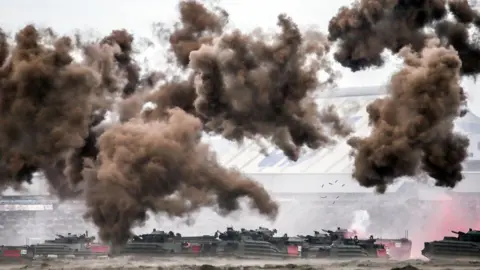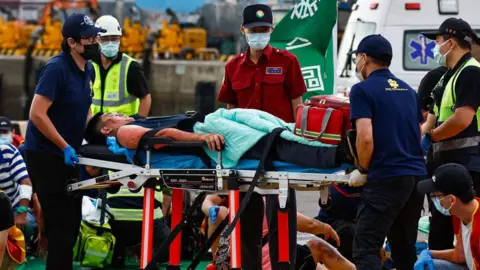What happens in Taiwan's military exercise to defend against China?
 Getty Images
Getty ImagesTaiwan's annual military exercise, Han Kuang, begins on Wednesday as the island ramps up its defence against a possible invasion from China.
Billed as the largest and longest one so far, this year's Han Kuang will last for about 10 days, about twice the duration of last year's drill.
While it is aimed at readying Taiwan's population for a possible attack, it is also meant to publicly showcase the island's defences and send a clear signal to Beijing.
China claims self-ruled Taiwan as its territory and has vowed to "reunify" with it some day, while not ruling out the use of force. This prospect has raised fears of a wider conflict drawing in the US, Taiwan's chief ally.
What is Han Kuang?
Held annually since 1984, Han Kuang sees thousands of troops take part in large-scale land, sea and air exercises that showcase Taiwan's latest military hardware.
While its full name in Chinese technically refers to the reclaiming of the Chinese mainland - one of the aims of Taiwan's first Republic of China government - its actual purpose is to rehearse Taiwan's defensive capabilities.
As concern over a possible attack from China has mounted in recent years, Han Kuang has evolved significantly.
What happens during the exercise?
This year, authorities held a series of computerised table-top military exercises in April, as a precursor to the live-fire drills that will be held from 9 to 18 July.
During this month's drills, hardware such as rocket launchers, drones, and locally developed missiles will be deployed.
This includes the much touted and newly acquired mobile rocket launch system Himars supplied by the US - the same system Washington has given to Ukraine - which has a much further range than current ones used by the Taiwan military.
The exercises will involve about 22,000 reservist troops - about 50% more than last year.
Like last year, the drills will be unscripted to test troops' response to a surprise attack - a move that has been praised by military analysts and seen as long overdue.
This change appears to have been made in response to criticism over the years that previous drills appeared to be more of a public relations exercise instead of an actual military exercise.
This year, part of the exercises will focus on combating China's increasing greyzone warfare tactics against Taiwan which have seen Beijing's fighter jets and ships repeatedly intrude in airspace and waters.
In recent years, Han Kuang has increasingly included civil defence. A separate exercise is held concurrently where civilians across the island participate in multiple evacuation and air raid rehearsals.
 Getty Images
Getty ImagesDuring this year's "urban resilience" drills, which will each last about 30 minutes, mobile phone alerts will be sent out about incoming attacks and air raid sirens will blare out in cities. Road traffic will be restricted while transport hubs, shops, hotels, and markets will have to suspend operations.
Authorities will also test Taiwanese society's ability to counter misinformation and the work of the Chinese Communist Party's United Front, according to reports, although it is unclear how exactly this would be tested.
Why is Taiwan ramping up Han Kuang?
China has been scaling up its greyzone warfare and disinformation campaigns in Taiwan, which some observers say are meant to wear down the island's defences.
The US has warned that China poses an "imminent threat" to Taiwan, referring to a 2027 deadline that President Xi Jinping has allegedly given for China's military to be capable of invading Taiwan.
This is a date that has never been confirmed by Beijing - however the US insists that China is "credibly preparing to potentially use military force to alter the balance of power" in Asia.
Relations between Taiwan and China have also become particularly tense under the Democratic Progressive Party's President William Lai, who was elected last year.
Reviled by Beijing as a "separatist", Lai has taken a more forceful stand against China compared to his predecessor, including beefing up Taiwan's military.
Unsurprisingly, Han Kuang displeases Beijing.
Senior Colonel Jiang Bin, spokesperson for China's Ministry of National Defense, said on Tuesday that this year's exercises are "nothing but a bluff and a self-deceiving trick played by the region's Democratic Progressive Party authorities to hijack Taiwan compatriots on board its 'Taiwan Independence' war chariot".
"Whatever subjects they drill and whatever weapons they use, the People's Liberation Army's resolute countermeasures against 'Taiwan Independence' would not be deterred, nor would the overwhelming and irresistible trend of China's national reunification be stopped," he added.
Why is this year's Han Kuang significant?
The changes in Han Kuang are actually part of a broader push to reform Taiwan's military and defence, which has come under criticism both domestically and externally in recent years.
The Taiwanese public's confidence in their own military fluctuates but has generally been middling, with one survey last year showing only 47.5% have confidence in their defence capabilities.
During both Trump administrations, the US has repeatedly pushed Taiwan to spend more on its defence and modernise its military.
The move to bolster their own defences comes as doubt grows in Taiwan that the US under Donald Trump would intervene militarily in the event of a Chinese attack.
The US is compelled by legislation to help Taiwan defend itself, but Trump has been ambiguous about this and recently refused to comment on whether he would stop China from taking Taiwan by force.
Besides the changes in Han Kuang, Taiwan in recent years has also moved to extend its compulsory military service, developed its own submarines and missiles, and built up its urban and civil defence capabilities.
It has also invested in smaller and more mobile weapons systems including drones, and upped its training of soldiers in asymmetric warfare as part of its so-called "porcupine" strategy aimed at making the island more difficult to capture.
